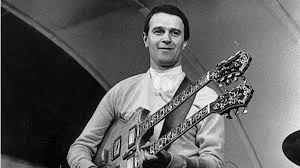I first heard Visions of the Emerald Beyond somewhere around junior year of high school. The music was foreign to me..it was so raw, loose, yet so creative and fresh compared what I thought was “fusion”, a la Chick Corea, Pat Metheny and Joe Zawinul. I didn’t know that fusion could sound like that! It was easy to get lost in the rich compositions, odd time signatures and tempo modulations; however, what really hooked me was listening to John McLaughlin shred away, no holds barred. As a guitarist, it opened me up to an entire new world of jazz fusion–I thought to myself, this is more my style!
John McLaughlin is an English guitar player, born in 1942. He was a sideman to many groups in the 60’s, including Jack Bruce and Ginger Baker’s group, The Graham Bond Quartet. He was rumored to have given guitar lessons to Jimmy Page and earned money doing session work in the area. He eventually released his first album as a bandleader in 1969, called Extrapolation. He moved to the U.S. shortly after that and hooked up with Miles Davis and Tony Williams, playing notable solos on many of the Miles early fusion albums–In A Silent Way, Bitches Brew and On The Corner. After that stint he collaborated with Carlos Santana, and even formed a group with Jaco Pastorius, although this was very short lived. It was during this time that he took on the name Mahavishnu, and formed the Mahavishnu Orchestra in 1971.
In my opinion, this is the cream of the crop from John McLaughlin. Any cursory listen to the Mahavishnu Orchestra albums will display a tremendous amount of talent, creativity and amazing playing by the band. The way they segue from super fast fusion jams to odd half-time signatures and back was one of a kind. They would often use a unison head line as way to transition to and from the various sections, and this was generally a very phased sound between keys, violin and guitar that I wasn’t aware of before this group. The style and sound is certainly unique. I think a lot of folks can get lost in the lightning array of notes flying at them, but the compositions themselves are really something to admire. Although they weren’t as tight sounding as Return to Forever, I don’t think that they ever cared, as that just wasn’t their style. They preferred the raw energy emanating from jams at 160+ bpm to pave the way. Unfortunately, the personality clashes were as incendiary as their music–the group did not stick together very long, only leaving us with 5 killer albums.
After Mahavishnu Orchestra called it quits, McLaughlin turned his energy to acoustic playing, with his group Shakti. He had been studying Indian music during that time period and the three albums that the group produced are a cool crossover between the Indian music and jazz worlds. It was in this group that McLaughlin debuted his custom steel string J-200 guitar, which featured two tiers of strings over the sound hole, one set turned at 45 degrees from the other. In addition to adding “sympathetic strings” that could be tuned differently, it allowed him the freedom to bend strings further than conventional guitars, and he eventually took the scalloped fretboard design over to his Gibson guitars.
Later in his career he was part of the infamous trio of himself, Paco de Lucia, and Al Dimeola. The Saturday Night In San Francisco album is one of the most popular acoustic jazz albums to date. From here he veered back to his Mahavishnu group, although this time omitting the “orchestra” from the title. He continued to work with many different types of musical situations throughout the next few decades, even performing with many classical orchestras. Most recently he was jamming at Chick Corea’s 75th birthday bash in NYC.
For me, what stands out about Mahavishnu John McLaughlin was the insane amount of raw energy streaming out from his fretboard. It is unlike many other guitar shredders in that it seems to come from a deeply spiritual place. When I first heard his playing, I felt comforted by the notion of just going out there and ripping it up, not caring what happened, just letting the energy flow out to the crowd. It made me worry less about being perfect and more concerned with delivering the correct feeling through my playing. Ultimately, his playing inspired me to create my own intense fusion compositions and the musical freedom to shred over them! I don’t know if there is another fusion band that was so creative for the times.
If you’ve never heard of our featured May guitar player, I suggest starting with the Mahavishnu Orchestra and going from there. It’s all good stuff–some of it delves more into the acoustic spiritual side and some of it goes balls to the wall fusion riffs. If you like it, try Shakti next!


Comments are closed.